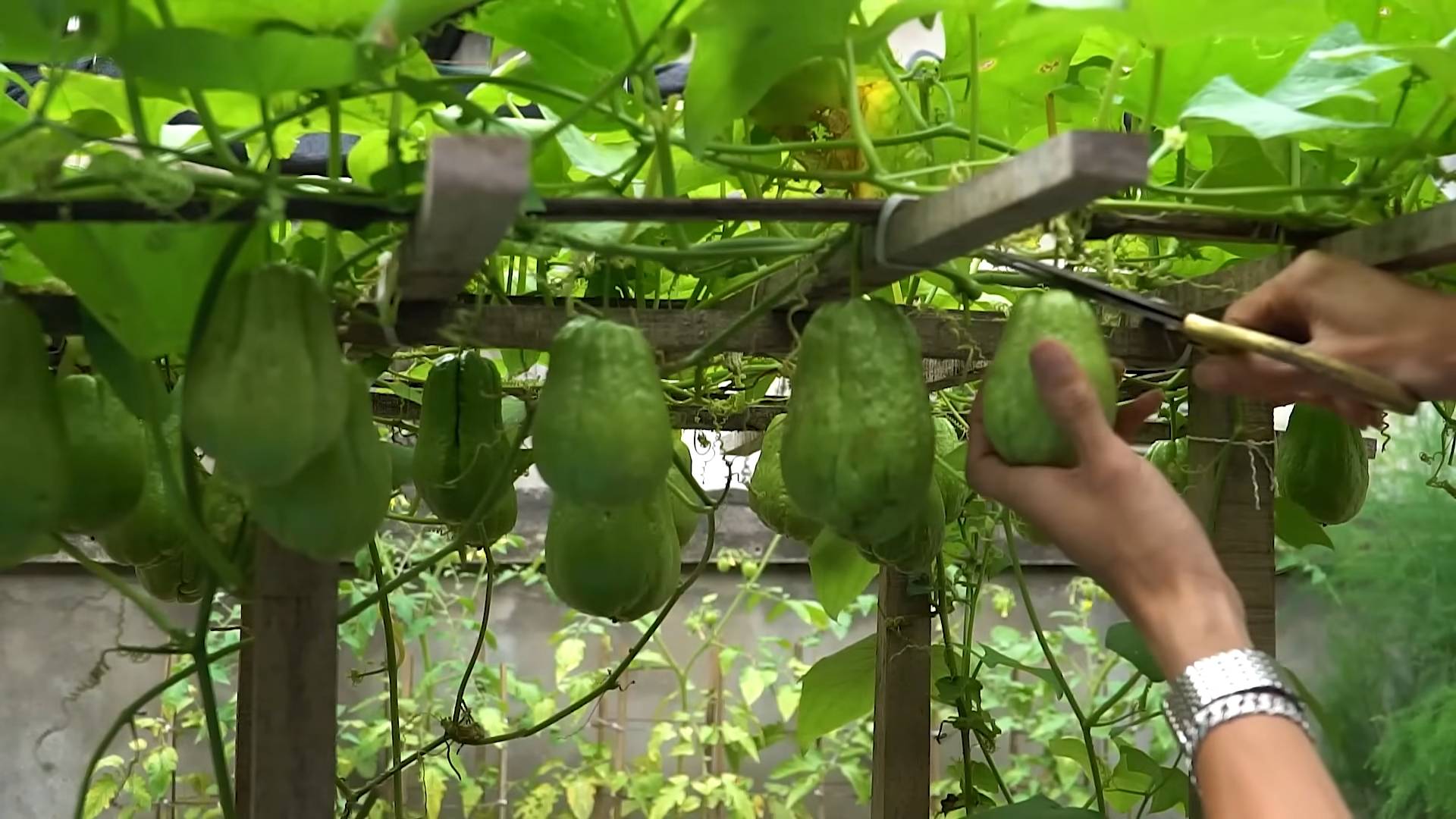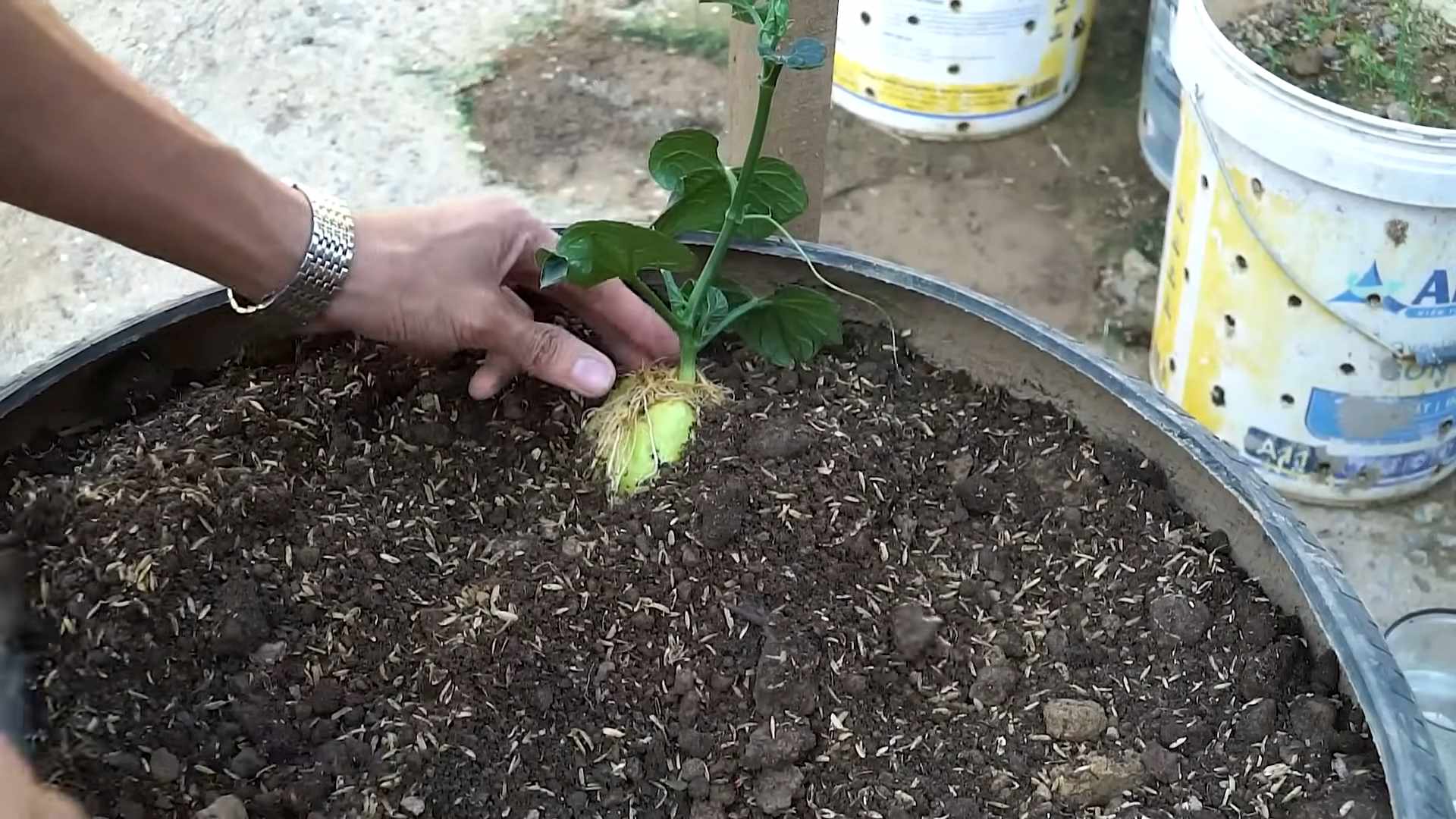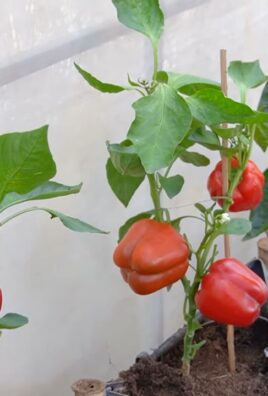Growing Potatoes in Bags: Imagine harvesting a bounty of fresh, homegrown potatoes right from your patio or balcony! No sprawling garden needed. For centuries, potatoes have been a staple food, nourishing communities across the globe, from the Andes Mountains where they originated to dinner tables worldwide. But what if you lack the space for a traditional potato patch? That’s where this ingenious DIY trick comes in!
I’m here to show you how to cultivate delicious potatoes using just bags, soil, and a little sunshine. This method is perfect for urban dwellers, apartment residents, or anyone with limited gardening space. Forget back-breaking digging and weeding; this technique simplifies the process, making it accessible to everyone, regardless of their gardening experience. Plus, it’s incredibly rewarding to witness those little sprouts transform into a harvest of flavorful potatoes.
In this article, I’ll guide you through each step, from selecting the right bag and soil to planting, watering, and harvesting your very own potato crop. Get ready to unlock the secrets of growing potatoes in bags and enjoy the taste of homegrown goodness!

Growing Potatoes in Bags: A Bountiful Harvest on Your Patio!
Hey there, fellow gardening enthusiasts! Are you dreaming of fresh, homegrown potatoes but short on garden space? Well, I’ve got the perfect solution for you: growing potatoes in bags! It’s a super easy and rewarding way to enjoy a potato harvest, even if you only have a balcony or patio. Trust me, once you try it, you’ll be hooked!
Why Grow Potatoes in Bags?
Before we dive into the how-to, let’s quickly cover why this method is so fantastic:
* Space-Saving: Bags take up minimal space compared to traditional garden beds.
* Easy Harvesting: No more digging around in the dirt! Just tip the bag over when it’s time to harvest.
* Control Over Soil: You can create the perfect growing medium for your potatoes.
* Portability: Move your potato plants around to find the sunniest spot.
* Fun and Educational: It’s a great project for kids and adults alike!
What You’ll Need
Okay, let’s gather our supplies. Here’s what you’ll need to get started:
* Large Bags: I recommend using sturdy grow bags (at least 15-20 gallons). You can also use burlap sacks, heavy-duty trash bags (with drainage holes), or even old feed bags. Just make sure they’re large enough to accommodate the growing potatoes.
* Seed Potatoes: These are potatoes specifically grown for planting. You can find them at your local garden center or online. Choose a variety that you enjoy eating!
* Potting Mix: A well-draining potting mix is crucial. I like to use a mix of compost, peat moss (or coco coir), and perlite.
* Fertilizer: A balanced fertilizer (like 10-10-10) will help your potatoes thrive.
* Watering Can or Hose: For keeping your potatoes hydrated.
* Scissors or Knife: For cutting drainage holes (if needed).
* Gloves: To keep your hands clean.
Step-by-Step Instructions: Planting Your Potatoes
Alright, let’s get our hands dirty! Here’s how to plant your seed potatoes in bags:
1. Prepare Your Seed Potatoes: A week or two before planting, take your seed potatoes out of their packaging and let them sit in a cool, bright place. This will encourage them to sprout “eyes.” If your seed potatoes are large (bigger than an egg), you can cut them into smaller pieces, making sure each piece has at least one or two eyes. Let the cut pieces dry for a day or two to prevent rotting.
2. Prepare Your Bags: If you’re using bags that don’t have drainage holes, cut several holes in the bottom to allow excess water to drain. This is super important to prevent your potatoes from rotting.
3. Add Initial Soil Layer: Fill the bottom of each bag with about 4-6 inches of your potting mix. Mix in a small amount of fertilizer according to the package directions.
4. Plant Your Seed Potatoes: Place 2-3 seed potato pieces (or whole small seed potatoes) on top of the soil, with the eyes facing up. Space them evenly apart.
5. Cover with Soil: Cover the seed potatoes with another 4-6 inches of potting mix.
6. Water Thoroughly: Water the soil well until it’s evenly moist but not soggy.
7. Place in a Sunny Location: Potatoes need at least 6-8 hours of sunlight per day, so place your bags in a sunny spot.
Step-by-Step Instructions: “Hilling” Your Potatoes
This is where the magic happens! “Hilling” is the process of adding more soil to the bag as the potato plants grow. This encourages the plants to produce more potatoes along the buried stem.
1. Wait for Sprouts: After a week or two, you should see sprouts emerging from the soil.
2. Add More Soil: When the sprouts are about 6-8 inches tall, add more potting mix to the bag, covering the stems up to the bottom set of leaves. Leave the top leaves exposed.
3. Repeat the Process: Continue adding soil every 1-2 weeks as the plants grow, always covering the stems up to the bottom leaves. This process is called “hilling.” Keep hilling until the bag is almost full.
4. Water Regularly: Keep the soil consistently moist, but avoid overwatering. Check the soil moisture by sticking your finger into the soil. If it feels dry an inch or two down, it’s time to water.
5. Fertilize Regularly: Continue to fertilize your potato plants every few weeks with a balanced fertilizer. Follow the package directions for application rates.
Step-by-Step Instructions: Caring for Your Potato Plants
Besides hilling and watering, here are a few other things you can do to keep your potato plants happy and healthy:
1. Monitor for Pests and Diseases: Keep an eye out for common potato pests like aphids, potato beetles, and flea beetles. You can control these pests with insecticidal soap or neem oil. Also, watch out for diseases like early blight and late blight. If you see signs of disease, remove the affected leaves and treat the plants with a fungicide.
2. Provide Support (Optional): As the potato plants grow taller, they may need some support. You can use stakes or a tomato cage to keep them from falling over.
3. Remove Flowers (Optional): Some gardeners recommend removing the flowers from potato plants to encourage them to put more energy into producing tubers. However, this is optional, and I’ve had good harvests both with and without removing the flowers.
Step-by-Step Instructions: Harvesting Your Potatoes
The most exciting part! Here’s how to harvest your homegrown potatoes:
1. Wait for the Right Time: Potatoes are typically ready to harvest about 80-100 days after planting, depending on the variety. The foliage will start to turn yellow and die back when the potatoes are mature.
2. Stop Watering: A week or two before harvesting, stop watering the plants to allow the potatoes to dry out slightly.
3. Harvesting: The easiest way to harvest potatoes from bags is to simply tip the bag over and dump out the contents. You can also reach into the bag and carefully dig around for the potatoes.
4. Cure Your Potatoes: After harvesting, let the potatoes dry in a cool, dark place for a few days to allow the skins to harden. This will help them store longer.
5. Store Your Potatoes: Store your cured potatoes in a cool, dark, and well-ventilated place. A root cellar is ideal, but a basement or garage will also work. Avoid storing potatoes near apples or onions, as they can cause them to spoil more quickly.
Troubleshooting Tips
Even with the best care, you might encounter a few challenges along the way. Here are some common problems and how to solve them:
* Potato Plants Not Growing: Make sure your seed potatoes are viable and that the plants are getting enough sunlight and water. Also, check the soil pH to make sure it’s in the optimal range (6.0-6.5).
* Yellowing Leaves: Yellowing leaves can be a sign of overwatering, underwatering, nutrient deficiency, or disease. Check the soil moisture and fertilize the plants if necessary. If you suspect disease, treat the plants with a fungicide.
* Small Potatoes: Small potatoes can be caused by overcrowding, lack of nutrients, or insufficient hilling. Make sure you’re spacing the seed potatoes properly, fertilizing regularly, and hilling the plants as they grow.
* Potatoes Rotting: Potatoes can rot if the soil is too wet or if they’re exposed to sunlight. Make sure the bags have good drainage and that the potatoes are properly cured and stored.
Choosing the Right Potato Variety
The type of potato you choose to grow will influence the taste, texture, and storage capabilities of your harvest. Here’s a quick rundown of some popular varieties:
* Russet Potatoes: These are the classic baking potatoes, known for their fluffy texture and earthy flavor. They store well and are great for fries and mashed potatoes.
* Yukon Gold Potatoes: These potatoes have a buttery flavor and creamy texture. They’re great for roasting, boiling, and mashing.
* Red Potatoes: These potatoes have a waxy texture and a slightly sweet flavor. They’re great for salads, boiling, and roasting.
* Fingerling Potatoes: These small, elongated potatoes have a firm texture and a nutty flavor. They’re great for roasting and grilling.
* Purple Potatoes: These potatoes have a vibrant purple color and a slightly earthy flavor. They’re great for adding color to salads and side dishes.

Conclusion
So, there you have it! Growing potatoes in bags is not just a gardening trend; it’s a game-changer for anyone, regardless of space or experience. This method offers a unique blend of convenience, control, and surprisingly bountiful harvests. Forget back-breaking digging and endless weeding in a traditional garden bed. With potato bags, you’re in charge of the environment, the soil, and ultimately, the size and quality of your potato crop.
Why is this DIY trick a must-try? Because it democratizes potato growing! Apartment dwellers with a sunny balcony, suburban families with limited yard space, and even seasoned gardeners looking for a more efficient method can all benefit. The ease of moving the bags allows you to chase the sun, protect your plants from unexpected frosts, and even bring them indoors if necessary. Plus, the “harvest as you go” approach is incredibly satisfying. Imagine reaching into your bag and pulling out fresh, homegrown potatoes whenever you need them for dinner! That’s the kind of garden-to-table experience that makes all the effort worthwhile.
But the benefits don’t stop there. Growing potatoes in bags also minimizes the risk of soilborne diseases and pests that can plague traditional potato patches. The controlled environment allows you to use high-quality, disease-free soil, giving your plants the best possible start. And let’s not forget the educational aspect! This is a fantastic project for kids, teaching them about plant life cycles, responsibility, and the joy of growing their own food.
Ready to take your potato growing to the next level? Consider experimenting with different potato varieties. From the creamy Yukon Gold to the vibrant Purple Majesty, each type offers a unique flavor and texture. You can also try adding different amendments to your soil mix, such as compost tea or bone meal, to boost nutrient levels and promote healthy growth. Another variation is to use different types of containers. While burlap bags are a classic choice, you can also use plastic grow bags, large buckets, or even repurposed containers like old tires (though be mindful of potential leaching).
Don’t be afraid to get creative and adapt the method to suit your specific needs and preferences. The key is to provide your potatoes with plenty of sunlight, well-draining soil, and consistent moisture. And most importantly, have fun! Growing your own food should be a rewarding and enjoyable experience.
We wholeheartedly encourage you to try this DIY trick and experience the magic of growing potatoes in bags for yourself. It’s a simple, effective, and incredibly satisfying way to enjoy fresh, homegrown potatoes, no matter where you live. Once you’ve harvested your first crop, we’d love to hear about your experience! Share your tips, tricks, and photos in the comments below. Let’s build a community of bag-growing enthusiasts and inspire others to discover the joys of homegrown potatoes. Happy growing!
Frequently Asked Questions (FAQs)
What type of potatoes are best for growing in bags?
The best potatoes for growing in bags are typically early-maturing varieties, often referred to as “new potatoes.” These varieties tend to produce smaller potatoes and mature more quickly, making them well-suited for the limited space of a bag. Some popular choices include Yukon Gold, Red Pontiac, Irish Cobbler, and fingerling potatoes like Russian Banana. However, you can certainly experiment with other varieties as well. Just keep in mind that larger, later-maturing varieties may require more space and time to reach their full potential. Consider the size of your bag and the available sunlight when making your selection.
What kind of soil should I use for growing potatoes in bags?
The ideal soil for growing potatoes in bags is a well-draining, nutrient-rich mix. A good starting point is a combination of equal parts potting soil, compost, and peat moss (or coconut coir as a sustainable alternative). The potting soil provides a good base, the compost adds essential nutrients and improves drainage, and the peat moss or coconut coir helps retain moisture. Avoid using garden soil, as it can be too heavy and compacted, hindering root growth and drainage. You can also amend your soil mix with slow-release fertilizer or organic amendments like bone meal or kelp meal to provide a sustained release of nutrients throughout the growing season. Remember, healthy soil is the foundation for healthy potato plants!
How often should I water my potatoes growing in bags?
Watering frequency depends on several factors, including the weather, the type of bag you’re using, and the stage of growth. Generally, you should aim to keep the soil consistently moist, but not waterlogged. Check the soil moisture level regularly by sticking your finger a few inches into the soil. If it feels dry to the touch, it’s time to water. During hot, dry weather, you may need to water daily, while during cooler, wetter periods, you may only need to water every few days. Avoid overwatering, as this can lead to root rot. When watering, water deeply, ensuring that the entire soil volume is moistened.
How much sunlight do potatoes in bags need?
Potatoes need at least six to eight hours of direct sunlight per day to thrive. Choose a location for your bags that receives ample sunlight throughout the day. If you live in a particularly hot climate, you may want to provide some afternoon shade to prevent the plants from overheating. If you don’t have access to a sunny outdoor space, you can also grow potatoes indoors under grow lights. However, you’ll need to ensure that the lights are strong enough and positioned correctly to provide adequate light for the plants.
How do I “hill” the potatoes in bags?
“Hilling” is the process of adding more soil to the bag as the potato plants grow. This encourages the plants to produce more potatoes along the buried stem. When the potato plants are about 6-8 inches tall, add more soil to the bag, covering the lower portion of the stems, leaving only the top few leaves exposed. Repeat this process every few weeks as the plants continue to grow, until the bag is nearly full. This technique maximizes potato production within the limited space of the bag.
When is the best time to harvest potatoes from bags?
The timing of your harvest will depend on the variety of potatoes you’re growing and your personal preference. For “new potatoes,” you can start harvesting when the plants begin to flower, typically about 70-80 days after planting. These potatoes will be small and tender, with thin skins. For larger, more mature potatoes, wait until the foliage begins to die back, usually around 90-100 days after planting. To harvest, simply reach into the bag and carefully remove the potatoes. You can harvest as needed, leaving the remaining potatoes in the bag to continue growing.
Can I reuse the soil from my potato bags?
Yes, you can reuse the soil from your potato bags, but it’s important to amend it before replanting. Potatoes are heavy feeders, so the soil will likely be depleted of nutrients after a growing season. Before reusing the soil, remove any remaining potato pieces or roots. Then, amend the soil with fresh compost, fertilizer, or other organic amendments to replenish the nutrients. You may also want to sterilize the soil to kill any potential pathogens or pests. This can be done by baking the soil in the oven or solarizing it in a black plastic bag.
What are some common problems when growing potatoes in bags and how can I prevent them?
Some common problems when growing potatoes in bags include pests like potato beetles and aphids, diseases like blight and scab, and nutrient deficiencies. To prevent these problems, start with disease-free seed potatoes, use high-quality soil, and provide adequate sunlight and water. Regularly inspect your plants for signs of pests or diseases and take action promptly if you notice any problems. You can use organic pest control methods like insecticidal soap or neem oil to control pests. To prevent diseases, ensure good air circulation around the plants and avoid overwatering. Fertilize your plants regularly to prevent nutrient deficiencies.




Leave a Comment